Blog
James Edward Heath (October 25, 1926 – January 19, 2020), nicknamed Little Bird, was an American jazzsaxophonist, composer, arranger, and big band leader. He was the brother of bassist Percy Heath and drummer Albert Heath.
Heath was born in Philadelphia on October 25, 1926. His father, an auto mechanic, played the clarinet, performing on the weekends. His mother sang in a church choir. The family frequently played recordings of big band jazz groups around the house. Heath’s sister was a pianist, while his brothers were bassist Percy Heath (older) and drummer Albert Heath (his youngest sibling).
more...Eddie Lang (born Salvatore Massaro; October 25, 1902 – March 26, 1933) was an American musician who is credited as the father of jazz guitar. During the 1920s, he gave the guitar a prominence it previously lacked as a solo instrument, as part of a band or orchestra, and as accompaniment for vocalists. He recorded duets with guitarists Lonnie Johnson and Carl Kress and jazz violinist Joe Venuti, and played rhythm guitar in the Paul Whiteman Orchestra and was the favoured accompanist of Bing Crosby. The son of an Italian-American instrument maker, Lang was born in Philadelphia, Pennsylvania, and grew up with violinist Joe Venuti. His first instrument was violin when he was seven. He performed on violin in 1917 and became a member of a trio. In 1920, he dropped the violin for banjo and worked with Charlie Kerr, then Bert Estlow, Vic D’Ippolito, and Billy Lustig‘s Scranton Siren Orchestra. A few years later, he dropped the banjo for guitar when he became a member of the Mound City Blue Blowers led by Red McKenzie. He recorded one of the first solos in 1924 on “Deep 2nd Street Blues”. His performances with McKenzie’s band drew attention, and he found many jobs as a freelance guitarist. Before Lang, the guitar hadn’t been a prominent instrument in jazz bands and dance orchestras. Lang suffered from occasional laryngitis, chronic sore throat, and digestion problems. After a doctor recommended a tonsillectomy, Crosby urged Lang to have the operation. Assured that the operation was routine, Lang entered Park West Hospital in Manhattan, but he never awoke from the surgery. He died at the age of thirty in 1933. The cause of his death is uncertain.
more...An Israeli ensemble blending Arabic music. This is a cross-cultural peace collaboration
more...a cosmic bridge of stars, gas, and dust currently stretches over 75,000 light-years and joins them. The bridge itself is strong evidence that these two immense star systems have passed close to each other and experienced violent tides induced by mutual gravity. As further evidence, the face-on spiral galaxy on the right, also known as NGC 3808A, exhibits many young blue star clusters produced in a burst of star formation. The twisted edge-on spiral on the left (NGC 3808B) seems to be wrapped in the material bridging the galaxies and surrounded by a curious polar ring. Together, the system is known as Arp 87. While such interactions are drawn out over billions of years, repeated close passages will ultimately create one merged galaxy. Although this scenario does look unusual, galactic mergers are thought to be common, with Arp 87 representing a stage inthis inevitable process. The Arp 87 dancing pair are about 300 million light-years distant toward the constellation of the Lion (Leo). The prominent edge-on spiral galaxy at the far left appears to be a more distant background galaxy and not involved in the on-going merger.
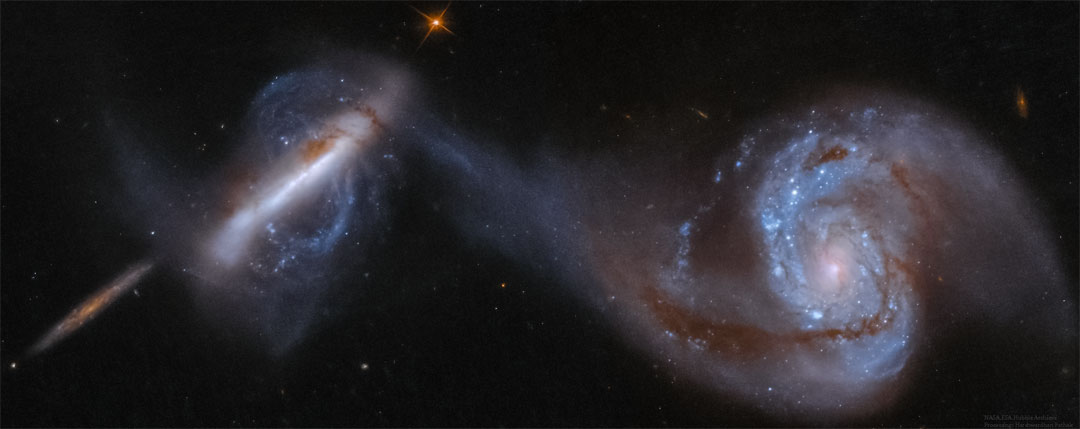
Odean Pope (born October 24, 1938) is an American jazz tenor saxophonist. Pope was raised in Philadelphia, where he learned from Ray Bryant while young. Early in his career, at Philadelphia’s Uptown Theater, Pope played behind a number of noted rhythm and blues artists including James Brown, Marvin Gaye and Stevie Wonder.
more...Willie James Mabon (October 24, 1925 – April 19, 1985) was an American R&B singer, songwriter, pianist, and harmonica player. He had two number one hits on the Billboard R&B chart, “I Don’t Know” in 1952 and “I’m Mad” in 1953.
Mabon was born and brought up in the Hollywood district of Memphis, Tennessee. He moved to Chicago in 1942, by which time he had become known as a singer and pianist. He formed a group, the Blues Rockers, and in 1949 began recording for Aristocrat Records and then Chess Records.
more...Saunders Terrell (October 24, 1911 – March 11, 1986), known as Sonny Terry, was an American Piedmont blues and folk musician, who was known for his energetic blues harmonica style, which frequently included vocal whoops and hollers and occasionally imitations of trains and fox hunts.
Terry was born in Greensboro, Georgia. His father, a farmer, taught him to play basic blues harp as a youth. He sustained injuries to his eyes and went blind by the time he was 16, which prevented him from doing farm work, and was forced to play music in order to earn a living. Terry played “Campdown Races” to the plow horses which improved the efficiency of farming in the area. He began playing blues in Shelby, North Carolina. After his father died, he began playing with Piedmont blues–style guitarist Blind Boy Fuller.When Fuller died in 1941, Terry established a long-standing musical relationship with Brownie McGhee, and they recorded numerous songs together. The duo became well known among white audiences during the folk music revival of the 1950s and 1960s, including for collaborations with Styve Homnick, Woody Guthrie and Moses Asch, producing classic recordings for Folkways Records (now Smithsonian/Folkways).
more...
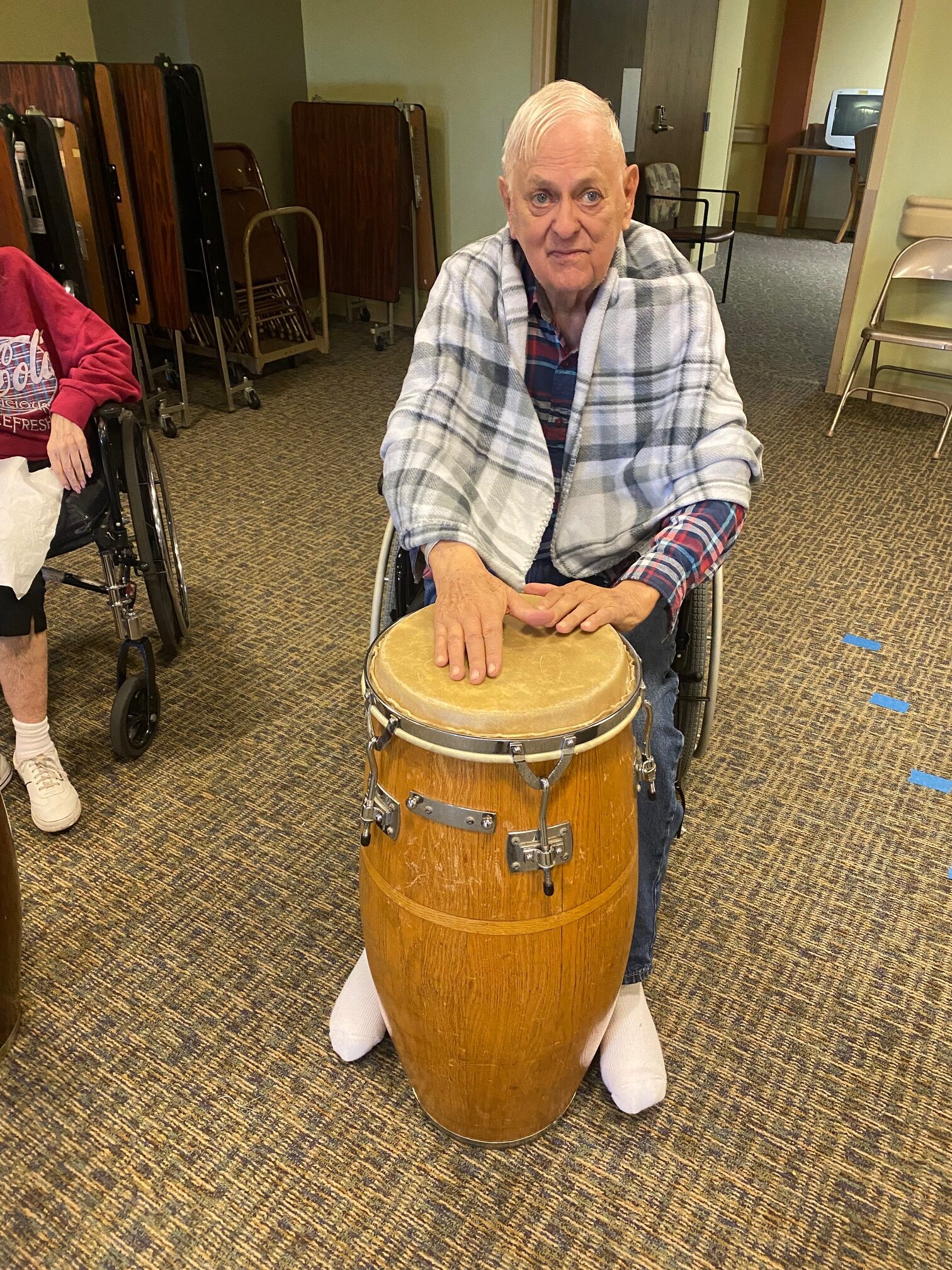
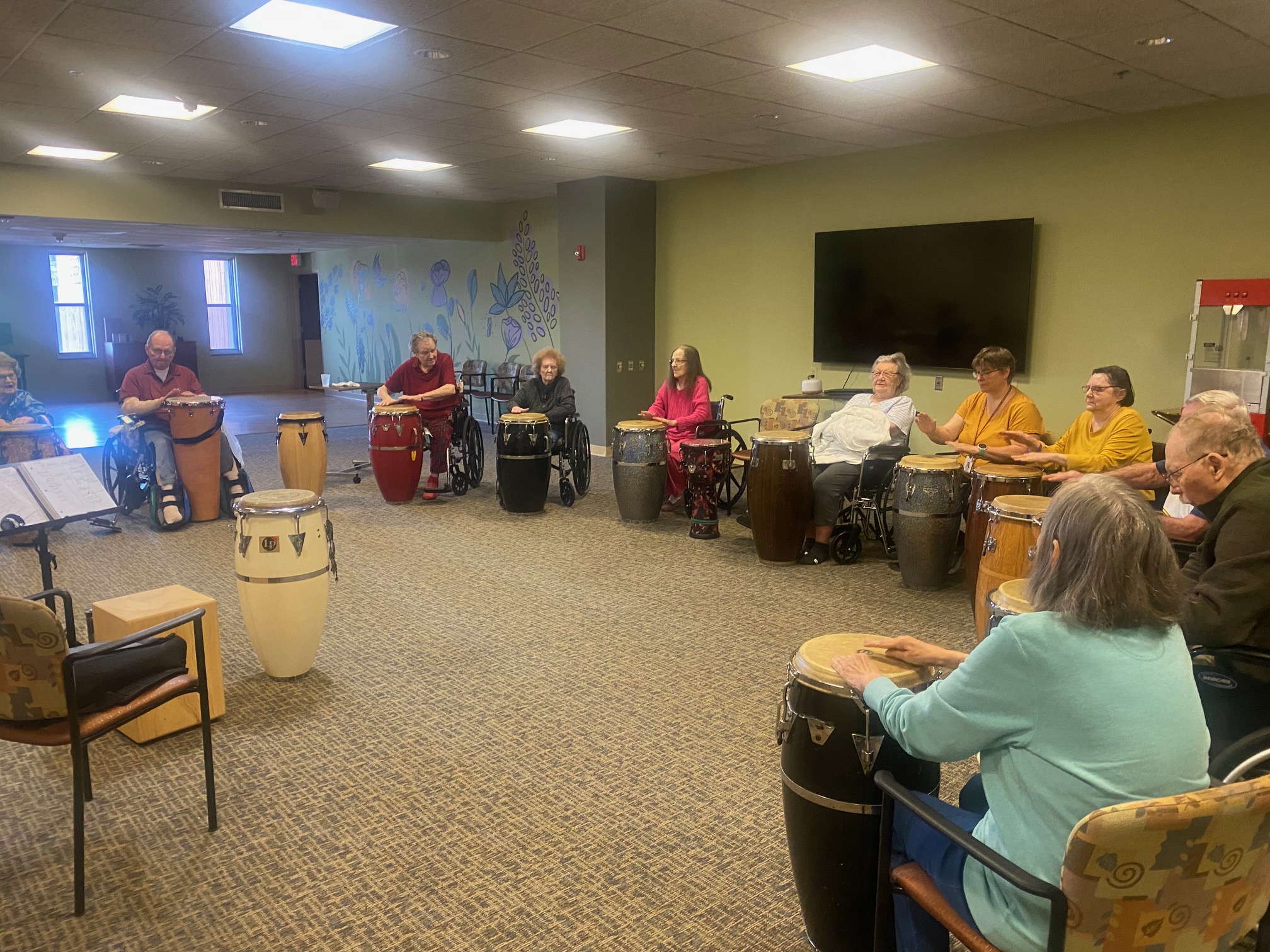
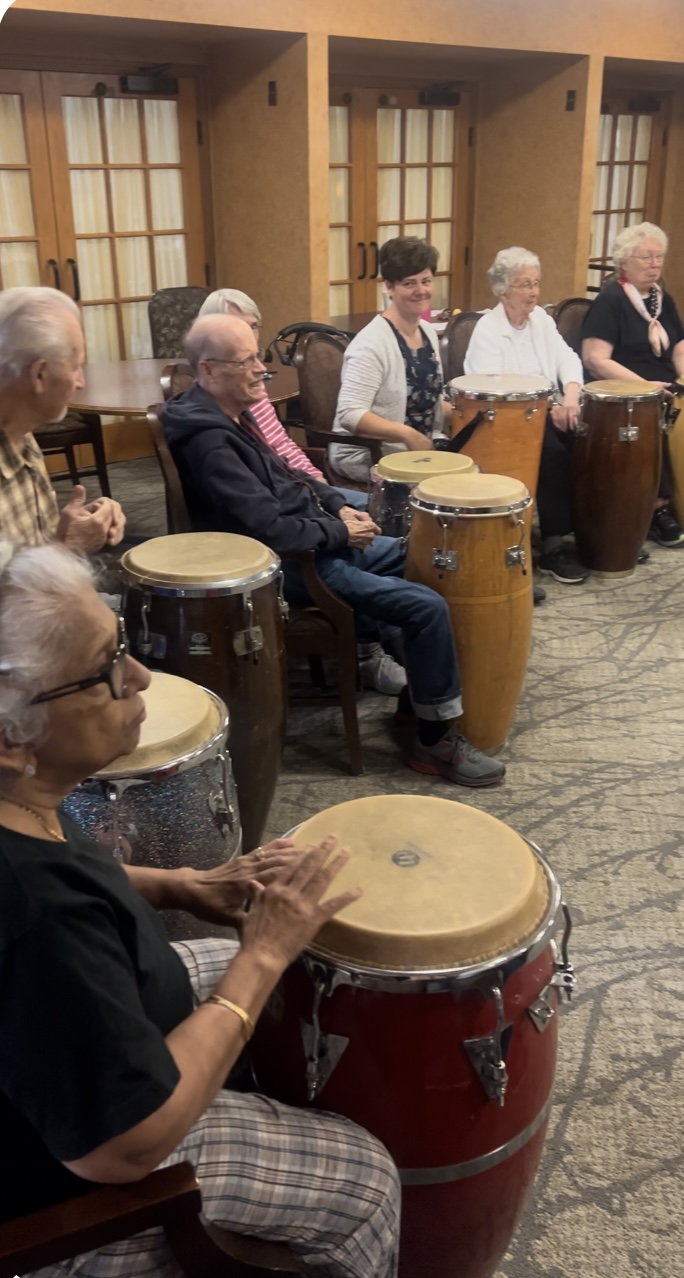
This striking image captures the interacting galaxy pair known as Arp-Madore 2339-661, so named because they belong to the Arp-Madore catalogue of peculiar galaxies. However, this particular peculiarity might be even odder than first meets the eye, as there are in fact three galaxies interacting here, not just two. The two clearly defined galaxies are NGC 7733 (smaller, lower right) and NGC 7734 (larger, upper left). The third galaxy is currently referred to as NGC 7733N, and can actually be spotted in this picture if you look carefully at the upper arm of NGC 7733, where there is a visually notable knot-like structure, glowing with a different colour to the arm and obscured by dark dust. This could easily pass as part of NGC 7733, but analysis of the velocities (speed, but also considering direction) involved in the galaxy shows that this knot has a considerable additional redshift, meaning that it is very likely its own entity and not part of NGC 7733. This is actually one of the many challenges that observational astronomers face: working out whether an astronomical object really is just one, or one lying in front of another as seen from Earth’s perspective! All three galaxies lie quite close to each other, roughly 500 million light-years from Earth in the constellation Tucana, and, as this image shows, they are interacting gravitationally with one another. In fact, some science literature refers to them as a ‘merging group’, meaning that they are on a course to ultimately become a single entity. [Image Description: Two spiral galaxies. Each glows brightly in the centre, where a bar stretches from side to side. The upper one is more round and its arms form two thin rings. The lower galaxy is flatter and its arms make one outer ring; a dusty knot atop its upper arm marks out a third object. Gravity is pulling gas and dust together where the galaxies come close. A number of small galaxies surround them on a black background.]
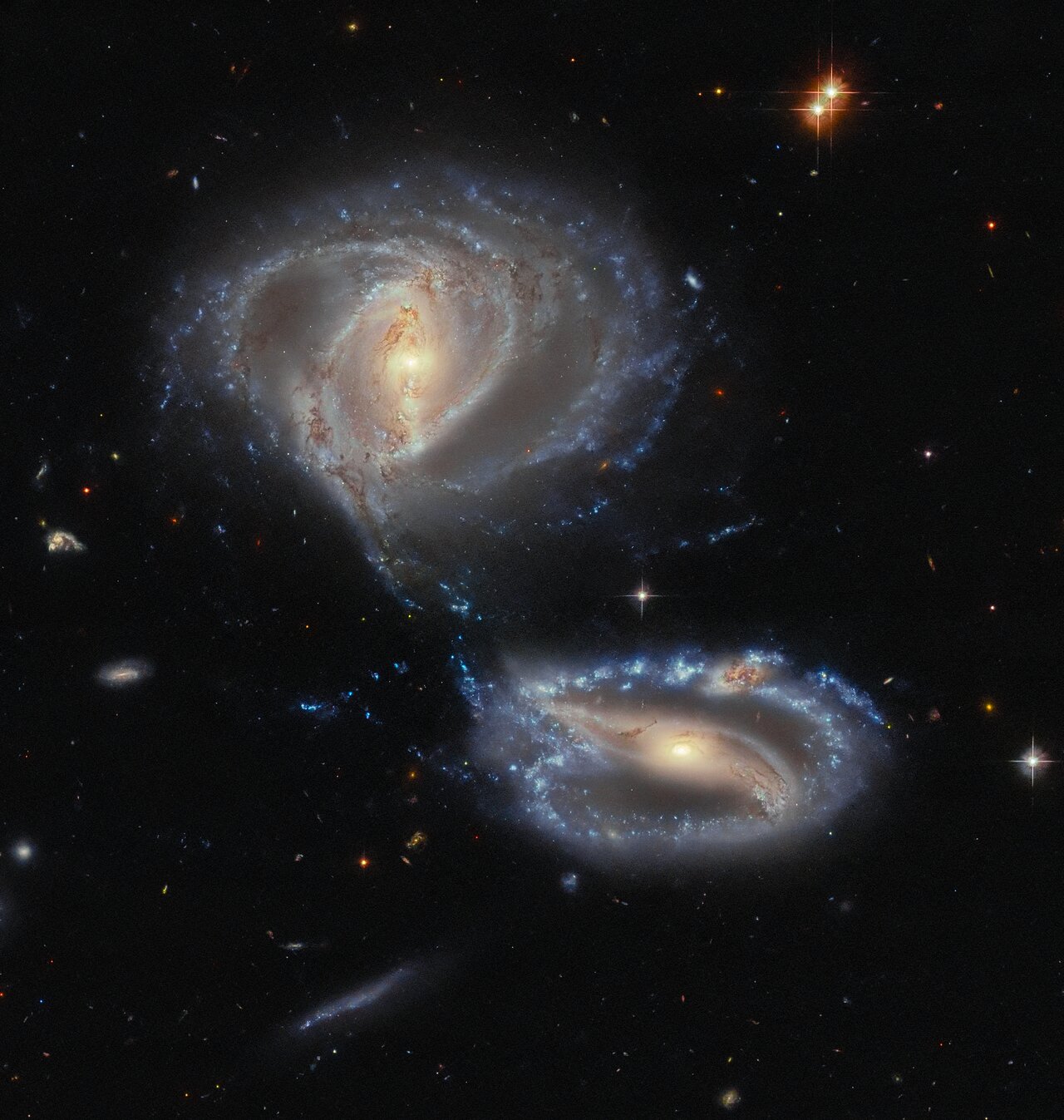
Ernest James Watts (born October 23, 1945) is an American jazz and rhythm and blues saxophonist who plays soprano, alto, and tenor saxophone. He has worked with Charlie Haden‘s Quartet West and toured with the Rolling Stones. On Frank Zappa‘s album The Grand Wazoo he played the “Mystery Horn”, a straight-necked C melody saxophone. He played the notable saxophone riff on “The One You Love” by Glenn Frey. Watts was born in Norfolk, Virginia, and began playing saxophone at thirteen. After a brief period at West Chester University, he attended the Berklee College of Music on a Down Beat magazine scholarship. He toured with Buddy Rich in the late-1960s, occupying one of the alto saxophone chairs. He visited Africa on a U.S. State Department tour with Oliver Nelson‘s group. For twenty years he played alto saxophone with The Tonight Show Band under Doc Severinsen. He was a featured soloist on many of Marvin Gaye‘s albums on Motown during the 1970s, as well as on many other pop and R&B sessions during his twenty-five years as a studio musician in Los Angeles. He has won two Grammy Awards as an instrumentalist.
https://www.youtube.com/watch?v=THmLkXB9Glk
more...Frank Hewitt (October 23, 1935 – September 5, 2002) was an American hard bop jazz pianist.
Born in Queens, New York, Hewitt lived most of his life in Harlem. His mother was a church pianist, and he initially studied classical and gospel music, but switched to jazz after hearing a Charlie Parker record. He took the bop pianists Thelonious Monk, Bud Powell and Elmo Hope as his role models. In the 1950s and 1960s, he worked with Howard McGhee, Cecil Payne, John Coltrane, Dinah Washington and Billie Holiday, among others; in 1961, he also participated in the Living Theater‘s production of Jack Gelber‘s The Connection. He became a regular figure in the circle of the pianist Barry Harris. In the 1990s, Hewitt became a central figure at New York’s Smalls Jazz Club; aside from playing there several nights a week, he sometimes also ended up using the walk-in refrigerator as a place to bunk when times were rough.
more...William “Sonny” Criss (23 October 1927 – 19 November 1977) was an American jazz musician.
An alto saxophonist of prominence during the bebop era of jazz, he was one of many players influenced by Charlie Parker.
William Criss was born in Memphis, Tennessee, United States, and moved to Los Angeles at the age of 15. He then went on to play in various bands including Howard McGhee‘s, which also featured Charlie Parker.
Criss had developed his own, concise, bluesy tone by this point, and though his basic style did not vary much, his ability on the instrument continued to develop. Nevertheless, he continued to drift from band to band, and played on some records with Johnny Otis and Billy Eckstine.
more...Corona Australis is a constellation in the Southern Celestial Hemisphere. Its Latin name means “southern crown”, and it is the southern counterpart of Corona Borealis, the northern crown. It is one of the 48 constellations listed by the 2nd-century astronomer Ptolemy, and it remains one of the 88 modern constellations. The Ancient Greeks saw Corona Australis as a wreath rather than a crown and associated it with Sagittarius or Centaurus. Other cultures have likened the pattern to a turtle, ostrich nest, a tent, or even a hut belonging to a rock hyrax.
Although fainter than its northern counterpart, the oval- or horseshoe-shaped pattern of its brighter stars renders it distinctive. Alpha and Beta Coronae Australis are the two brightest stars with an apparent magnitude of around 4.1. Epsilon Coronae Australis is the brightest example of a W Ursae Majoris variable in the southern sky. Lying alongside the Milky Way, Corona Australis contains one of the closest star-forming regions to the Solar System—a dusty dark nebula known as the Corona Australis Molecular Cloud, lying about 430 light years away. Within it are stars at the earliest stages of their lifespan. The variable stars R and TY Coronae Australis light up parts of the nebula, which varies in brightness accordingly.
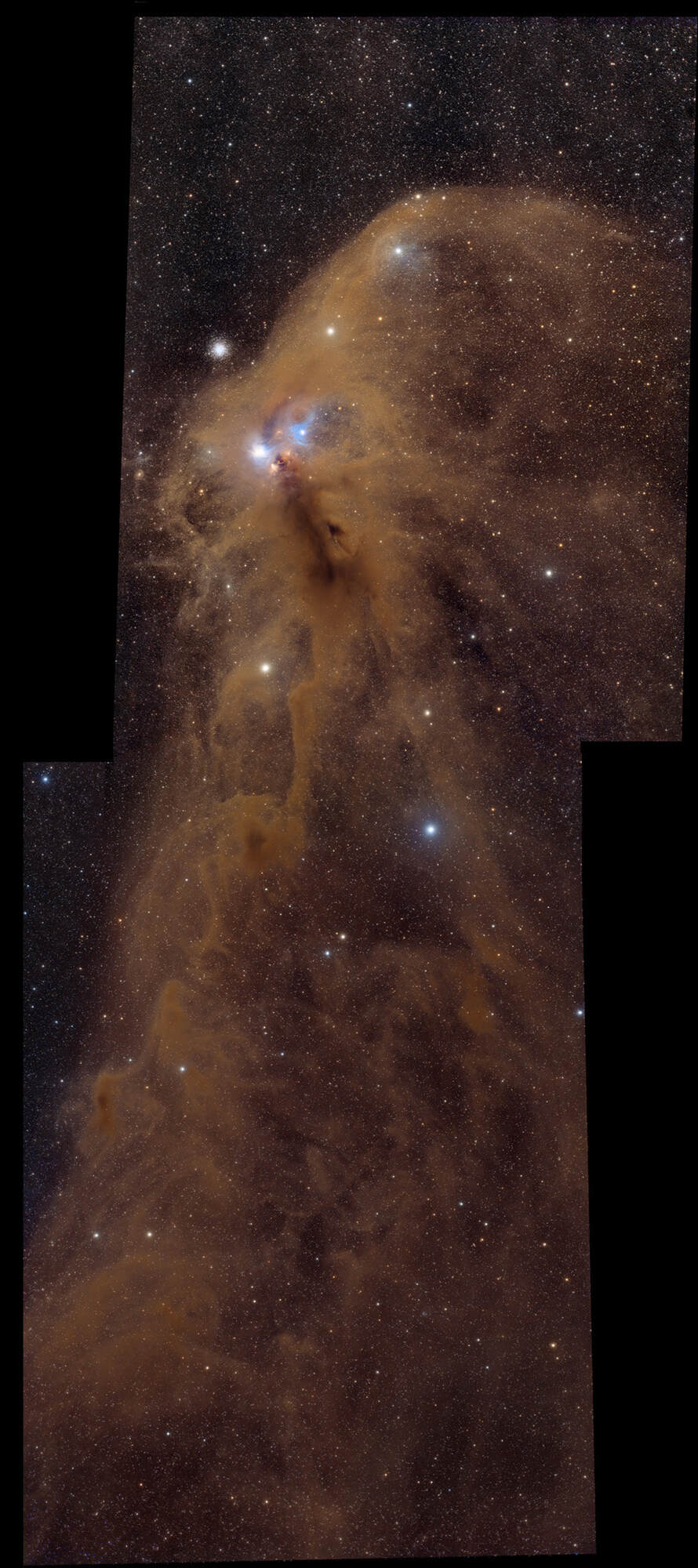
Leslie Abel West (born Weinstein; October 22, 1945 – December 23, 2020) was an American guitarist, singer and songwriter. He was the co-founder, guitarist and co-lead vocalist of the rock band Mountain. West was named the 245th greatest guitarist of all time by Rolling Stone in 2023.
West was born in New York City on October 22, 1945, to Jewish parents. He grew up in Hackensack, New Jersey, and in East Meadow, Forest Hills, and Lawrence, New York. After his parents divorced, he changed his surname to West. His musical career began with the Vagrants, an R&B/blue-eyed soul-rock band influenced by the likes of the Rascals that was one of the few teenage garage rock acts to come out of the New York metropolitan area itself (as opposed to the Bohemian Greenwich Village scene of artists, poets, and affiliates of the Beat Generation, which produced bands like the Fugs and the Velvet Underground). The Vagrants had two minor hits in the Eastern United States: 1966’s “I Can’t Make a Friend” and a cover of Otis Redding‘s “Respect” the following year.
more...Franz Liszt (22 October 1811 – 31 July 1886) was a Hungarian composer, virtuoso pianist, conductor, and teacher of the Romantic period. With a diverse body of work spanning more than six decades, he is considered to be one of the most prolific and influential composers of his era and remains one of the most popular composers in modern concert piano repertoire.
Liszt first gained renown during the early nineteenth century for his virtuoso skill as a pianist. Regarded as one of the greatest pianists of all time, he toured Europe during the 1830s and 1840s, often playing for charity. In these years, Liszt developed a reputation for his powerful performances as well as his physical attractiveness. In what has now been dubbed “Lisztomania“, he rose to a degree of stardom and popularity among the public not experienced by the virtuosos who preceded him — whereas earlier performers mostly served the upper class, Liszt attracted a more general audience. During this period and into his later life, Liszt was a friend, musical promoter and benefactor to many composers of his time, including Frédéric Chopin, Charles-Valentin Alkan, César Franck, Richard Wagner, Hector Berlioz, Robert Schumann, Clara Schumann, Camille Saint-Saëns, Edvard Grieg, Ole Bull, Joachim Raff, Mikhail Glinka, and Alexander Borodin.
Liszt was one of the most prominent representatives of the New German School (German: Neudeutsche Schule). He left behind an extensive and diverse body of work that influenced his forward-looking contemporaries and anticipated 20th-century ideas and trends. Among Liszt’s musical contributions were the symphonic poem, developing thematic transformation as part of his experiments in musical form, and radical innovations in harmony. Liszt has also been regarded as a forefather of Impressionism in music, with his Années de pèlerinage, often regarded as his masterwork, featuring many impressionistic qualities. In a radical departure from his earlier compositional styles, many of Liszt’s later works also feature experiments in atonality, foreshadowing the serialist movement of the 20th century.
more...More Posts
- Smiley Lewis Day
- World Music with Aladár Csiszár
- Daily Roots with Winston McAnuff
- Happy 4th of July 2018
- The Cosmos with NGC 6946
- Bill Withers Day
- Fred Wesley Day
- World Music with Stony Point
- Daily Roots with the Revolutionaries
- The Cosmos with UGC 5340
- Dr Lonnie Smith Day
- Johnny Coles Day
- World Music with Nadya Giga and Their 101 Candles Orchestra
- Daily Roots with Cornell Campbell
- The Cosmos with the Antares
- Charlie Watts Day
- Ahmed Jamal Day
- World Music with Mamady Keita
- Daily Roots with Leroy Smart
- The Cosmos with IC 5332